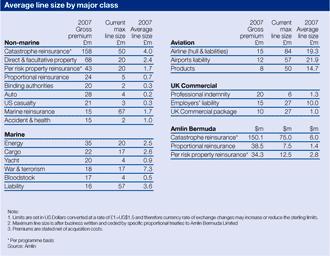Review
Underwriting – managing profitability through a changing environment
Managing exposures within risk appetite
The management of catastrophe exposure is a key area of our underwriting expertise. As explained previously the importance of diversity is core to our underwriting philosophy and this is also a feature of our aggregate exposure management whereby a broad spread of territorial exposures is underwritten and peak aggregations are carefully controlled.
This is especially the case where we have underwritten risks from several different classes of business, for example direct property, marine and reinsurance, which may aggregate and combine in a single loss event. Good systems for accurate data capture and modelling of potential scenarios are key elements in the discipline of exposure management.
There are areas of the world in which aggregate values are high and catastrophe exposure results in a high demand for coverage. The Board agrees a set of maximum net of reinsurance RDS limits or appetites for each of the major geographical peak zones.
Average line size by major class

Click here for full sized image
This appetite is measured and flexed against the anticipated or planned underwriting profit generated by the business (from both catastrophe and non catastrophe writings) and by reference to the net assets of the Group. In circumstances where underwriting returns are expected to be high we are prepared to accept larger levels of net loss from a major event proportionate to net tangible assets. Conversely, when market conditions are weaker and underwriting returns are lower we would expect to reduce the net impact of a major event as a share of net tangible assets.
In line with this underwriting strategy we have increased or decreased our risk appetite as shown in the table below. As conditions have weakened since 2006, our appetite expressed as a percentage of net tangible assets has reduced.

